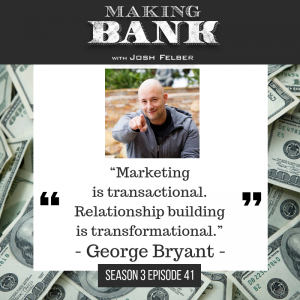
Technology gives us a lot of good. It makes our lives easier, more convenient, and connects us to friends and family thousands of miles away; but, it’s also created a fair amount of distance in regard to face-to-face interaction. So much of our communication is done digitally — we’ve sacrificed tangible human interaction.
People hunger for connection. This distance has grown so wide, people don’t really know how to close the gap, and it’s a problem that spans not only personal interactions but business interactions as well. George Bryant built a marketing career by seeing the gap and figuring out how to close it by fortifying relationships between customers and companies believing it’s not just business, it’s personal.
Take a step back in time to the 1950s. People used to walk through a store door and know the proprietor’s name, their family, and what was going on in their life. The relationship wasn’t predicated on transaction alone. In thinking about how we do business now, obviously, a lot has changed. We’ve lost the personal connection, the relationship built on trust that led to a positive experience in exchange of goods.

Analyze your business through this lens: “If marketing is transactional, relationship building is transformational.” What are the areas of your business that feel purely transactional? Is there a way to shift from transaction to relational transformation?
One good way to start is George’s Grandmother Test. Ask yourself, ‘Would I be okay if my 96-year-old grandmother went through my funnel, along my customer journey, and consumed my products?’
The Purchasing Journey: Would she feel excited about completing the transaction and want to share the brand with other people? Or would she feel guilty having spent money on something that didn’t fulfill the expectation she had? Remember, the majority of marketing is done word of mouth, interpersonal recommendations — so regardless of whether your grandmother got to the end of the funnel and bought or not, would she have enjoyed the journey of the sale? Does she leave the page taken care of?
The In-Between: Say she does buy the product – what do you do between the purchase and getting it to the door? Does your grandmother know what’s coming and when? Give your customer a high expectation and then live up to it, so their experience in between purchase and receipt is one of positive anticipation.
Education: When she gets the product, does she know how to use it? You have to educate your customer. Make sure they are fully supported and aware of all the uses for the product, assembly instructions, cleaning procedures. Whatever it may be, give them the tools they need to succeed with what you’ve sold them. How-To videos are your best friend for this!
Connection: Most importantly, are they connected to the brand? If not, then why do you expect anyone else to be? Your purchasing journey should inform, educate, and endear you to your customer. Once they know what you do, why you’re doing it, how you can help them (even if they don’t purchase), and the practical steps to make their life easier with your product, they will feel connected, cared for, and excited about what you do.

There is so much noise and competition now. People are only building relationships with brands that reach beyond the transaction. Solve problems. Overcome objections. Figure out why people aren’t buying. A big reason might lie in a missed or unfulfilled step above.
George gave tons more incredible insights, so make sure to give the podcast a listen again to refresh your mind on cart abandonment, gifting tactics, and the 7 Guiding Principles of Transformational Marketing.
To learn more from George, you can find him on Facebook at Marketing with George Bryant or on Instagram @CivilizedCaveman.
This is a Contributor Post. Opinions expressed here are opinions of the Contributor. Influencive does not endorse or review brands mentioned; does not and cannot investigate relationships with brands, products, and people mentioned and is up to the Contributor to disclose. Contributors, amongst other accounts and articles may be professional fee-based.

